2000 NISSAN MAXIMA air condition
[x] Cancel search: air conditionPage 5 of 239

Table of
Contents
Seats, restraints and supplemental air bag systemsInstruments and controlsPre-driving checks and adjustmentsHeater, air conditioner and audio systemsStarting and drivingIn case of emergencyAppearance and careDo-it-yourselfMaintenanceTechnical and consumer informationIndex
Z
00.1.17/A33-D/V5.0
X
Page 19 of 239
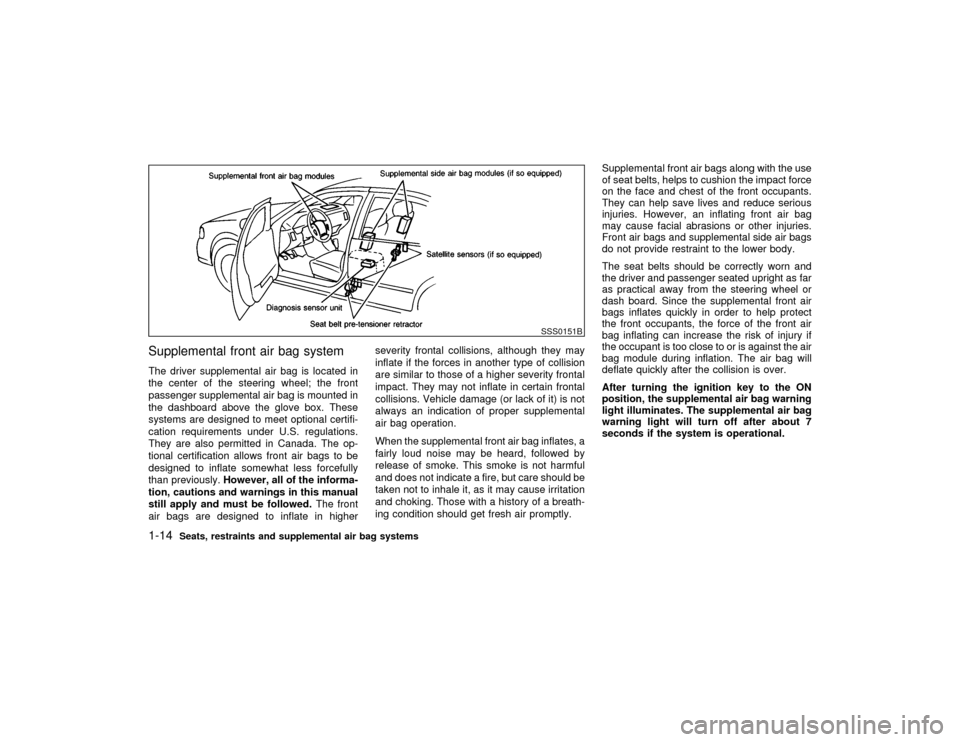
Supplemental front air bag systemThe driver supplemental air bag is located in
the center of the steering wheel; the front
passenger supplemental air bag is mounted in
the dashboard above the glove box. These
systems are designed to meet optional certifi-
cation requirements under U.S. regulations.
They are also permitted in Canada. The op-
tional certification allows front air bags to be
designed to inflate somewhat less forcefully
than previously.However, all of the informa-
tion, cautions and warnings in this manual
still apply and must be followed.The front
air bags are designed to inflate in higherseverity frontal collisions, although they may
inflate if the forces in another type of collision
are similar to those of a higher severity frontal
impact. They may not inflate in certain frontal
collisions. Vehicle damage (or lack of it) is not
always an indication of proper supplemental
air bag operation.
When the supplemental front air bag inflates, a
fairly loud noise may be heard, followed by
release of smoke. This smoke is not harmful
and does not indicate a fire, but care should be
taken not to inhale it, as it may cause irritation
and choking. Those with a history of a breath-
ing condition should get fresh air promptly.Supplemental front air bags along with the use
of seat belts, helps to cushion the impact force
on the face and chest of the front occupants.
They can help save lives and reduce serious
injuries. However, an inflating front air bag
may cause facial abrasions or other injuries.
Front air bags and supplemental side air bags
do not provide restraint to the lower body.
The seat belts should be correctly worn and
the driver and passenger seated upright as far
as practical away from the steering wheel or
dash board. Since the supplemental front air
bags inflates quickly in order to help protect
the front occupants, the force of the front air
bag inflating can increase the risk of injury if
the occupant is too close to or is against the air
bag module during inflation. The air bag will
deflate quickly after the collision is over.
After turning the ignition key to the ON
position, the supplemental air bag warning
light illuminates. The supplemental air bag
warning light will turn off after about 7
seconds if the system is operational.
SSS0151B
1-14
Seats, restraints and supplemental air bag systems
Z
00.1.17/A33-D/V5.0
X
Page 21 of 239
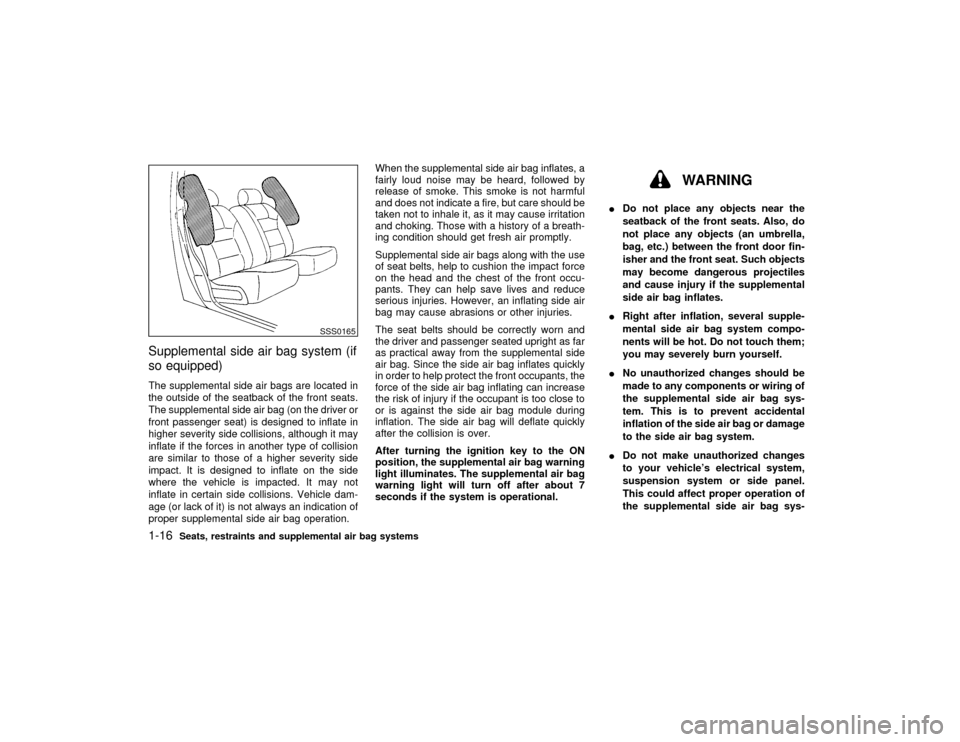
Supplemental side air bag system (if
so equipped)The supplemental side air bags are located in
the outside of the seatback of the front seats.
The supplemental side air bag (on the driver or
front passenger seat) is designed to inflate in
higher severity side collisions, although it may
inflate if the forces in another type of collision
are similar to those of a higher severity side
impact. It is designed to inflate on the side
where the vehicle is impacted. It may not
inflate in certain side collisions. Vehicle dam-
age (or lack of it) is not always an indication of
proper supplemental side air bag operation.When the supplemental side air bag inflates, a
fairly loud noise may be heard, followed by
release of smoke. This smoke is not harmful
and does not indicate a fire, but care should be
taken not to inhale it, as it may cause irritation
and choking. Those with a history of a breath-
ing condition should get fresh air promptly.
Supplemental side air bags along with the use
of seat belts, help to cushion the impact force
on the head and the chest of the front occu-
pants. They can help save lives and reduce
serious injuries. However, an inflating side air
bag may cause abrasions or other injuries.
The seat belts should be correctly worn and
the driver and passenger seated upright as far
as practical away from the supplemental side
air bag. Since the side air bag inflates quickly
in order to help protect the front occupants, the
force of the side air bag inflating can increase
the risk of injury if the occupant is too close to
or is against the side air bag module during
inflation. The side air bag will deflate quickly
after the collision is over.
After turning the ignition key to the ON
position, the supplemental air bag warning
light illuminates. The supplemental air bag
warning light will turn off after about 7
seconds if the system is operational.
WARNING
IDo not place any objects near the
seatback of the front seats. Also, do
not place any objects (an umbrella,
bag, etc.) between the front door fin-
isher and the front seat. Such objects
may become dangerous projectiles
and cause injury if the supplemental
side air bag inflates.
IRight after inflation, several supple-
mental side air bag system compo-
nents will be hot. Do not touch them;
you may severely burn yourself.
INo unauthorized changes should be
made to any components or wiring of
the supplemental side air bag sys-
tem. This is to prevent accidental
inflation of the side air bag or damage
to the side air bag system.
IDo not make unauthorized changes
to your vehicle's electrical system,
suspension system or side panel.
This could affect proper operation of
the supplemental side air bag sys-
SSS0165
1-16
Seats, restraints and supplemental air bag systems
Z
00.1.17/A33-D/V5.0
X
Page 24 of 239
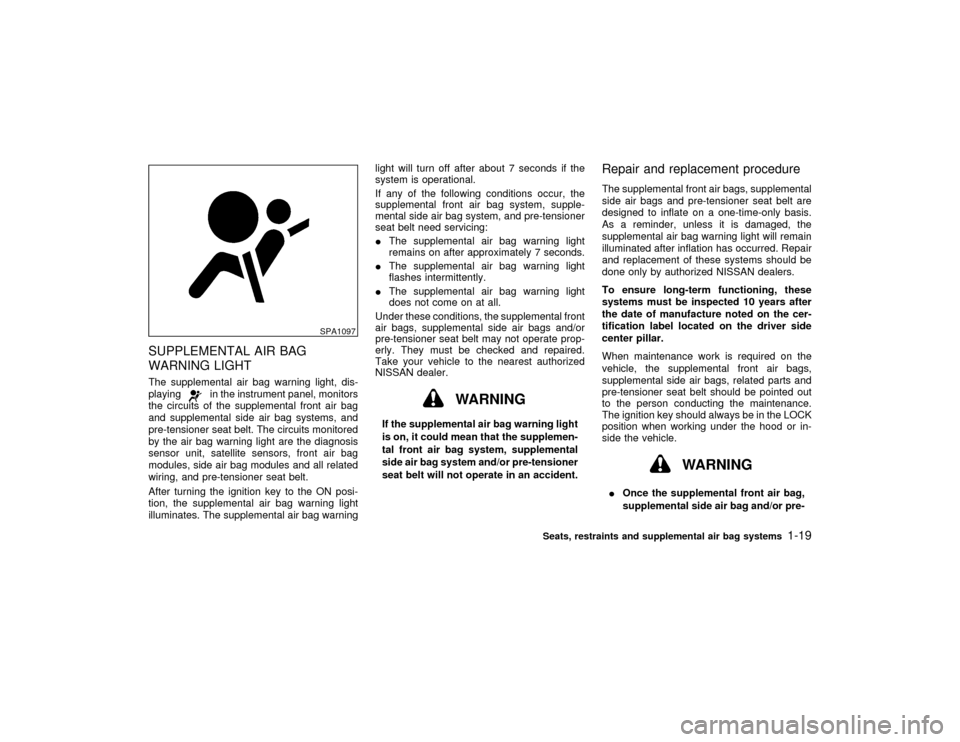
SUPPLEMENTAL AIR BAG
WARNING LIGHTThe supplemental air bag warning light, dis-
playing
in the instrument panel, monitors
the circuits of the supplemental front air bag
and supplemental side air bag systems, and
pre-tensioner seat belt. The circuits monitored
by the air bag warning light are the diagnosis
sensor unit, satellite sensors, front air bag
modules, side air bag modules and all related
wiring, and pre-tensioner seat belt.
After turning the ignition key to the ON posi-
tion, the supplemental air bag warning light
illuminates. The supplemental air bag warninglight will turn off after about 7 seconds if the
system is operational.
If any of the following conditions occur, the
supplemental front air bag system, supple-
mental side air bag system, and pre-tensioner
seat belt need servicing:
IThe supplemental air bag warning light
remains on after approximately 7 seconds.
IThe supplemental air bag warning light
flashes intermittently.
IThe supplemental air bag warning light
does not come on at all.
Under these conditions, the supplemental front
air bags, supplemental side air bags and/or
pre-tensioner seat belt may not operate prop-
erly. They must be checked and repaired.
Take your vehicle to the nearest authorized
NISSAN dealer.
WARNING
If the supplemental air bag warning light
is on, it could mean that the supplemen-
tal front air bag system, supplemental
side air bag system and/or pre-tensioner
seat belt will not operate in an accident.
Repair and replacement procedureThe supplemental front air bags, supplemental
side air bags and pre-tensioner seat belt are
designed to inflate on a one-time-only basis.
As a reminder, unless it is damaged, the
supplemental air bag warning light will remain
illuminated after inflation has occurred. Repair
and replacement of these systems should be
done only by authorized NISSAN dealers.
To ensure long-term functioning, these
systems must be inspected 10 years after
the date of manufacture noted on the cer-
tification label located on the driver side
center pillar.
When maintenance work is required on the
vehicle, the supplemental front air bags,
supplemental side air bags, related parts and
pre-tensioner seat belt should be pointed out
to the person conducting the maintenance.
The ignition key should always be in the LOCK
position when working under the hood or in-
side the vehicle.
WARNING
IOnce the supplemental front air bag,
supplemental side air bag and/or pre-
SPA1097
Seats, restraints and supplemental air bag systems
1-19
Z
00.1.17/A33-D/V5.0
X
Page 47 of 239
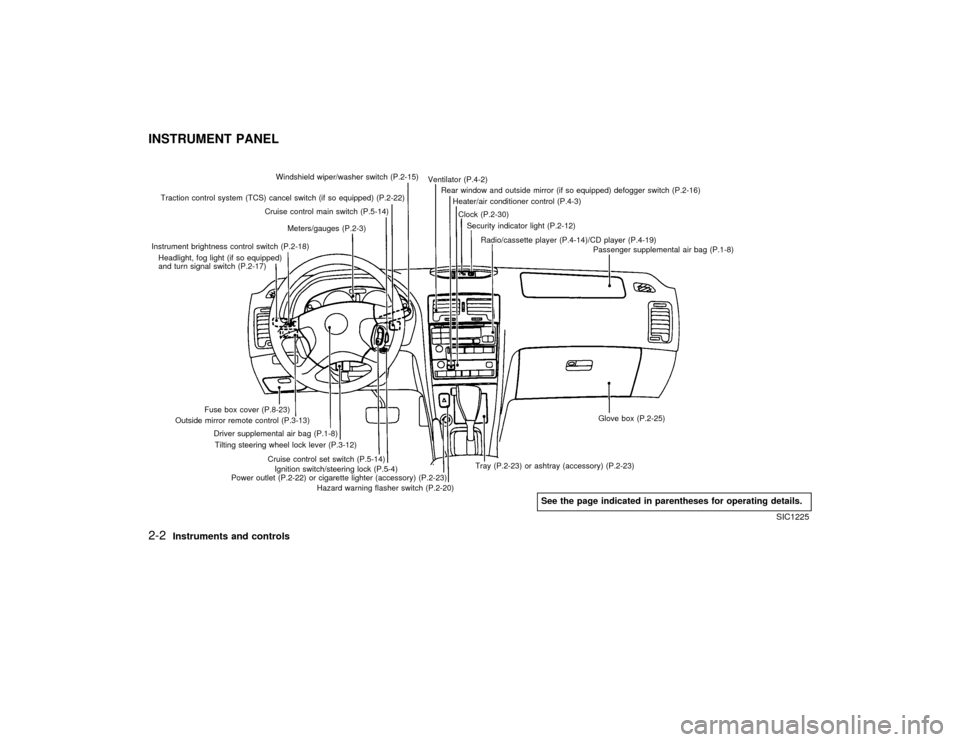
Windshield wiper/washer switch (P.2-15)
Instrument brightness control switch (P.2-18)Meters/gauges (P.2-3)Security indicator light (P.2-12) Cruise control main switch (P.5-14)
Headlight, fog light (if so equipped)
and turn signal switch (P.2-17)
Outside mirror remote control (P.3-13)Fuse box cover (P.8-23)
Tilting steering wheel lock lever (P.3-12) Driver supplemental air bag (P.1-8)
Ignition switch/steering lock (P.5-4) Cruise control set switch (P.5-14)
Power outlet (P.2-22) or cigarette lighter (accessory) (P.2-23)
Hazard warning flasher switch (P.2-20)Ventilator (P.4-2)
Heater/air conditioner control (P.4-3)
Clock (P.2-30)
Radio/cassette player (P.4-14)/CD player (P.4-19) Rear window and outside mirror (if so equipped) defogger switch (P.2-16)
Passenger supplemental air bag (P.1-8)
Glove box (P.2-25)
Tray (P.2-23) or ashtray (accessory) (P.2-23)
SIC1225
See the page indicated in parentheses for operating details.
Traction control system (TCS) cancel switch (if so equipped) (P.2-22)
INSTRUMENT PANEL2-2
Instruments and controls
Z
00.1.17/A33-D/V5.0
X
Page 53 of 239
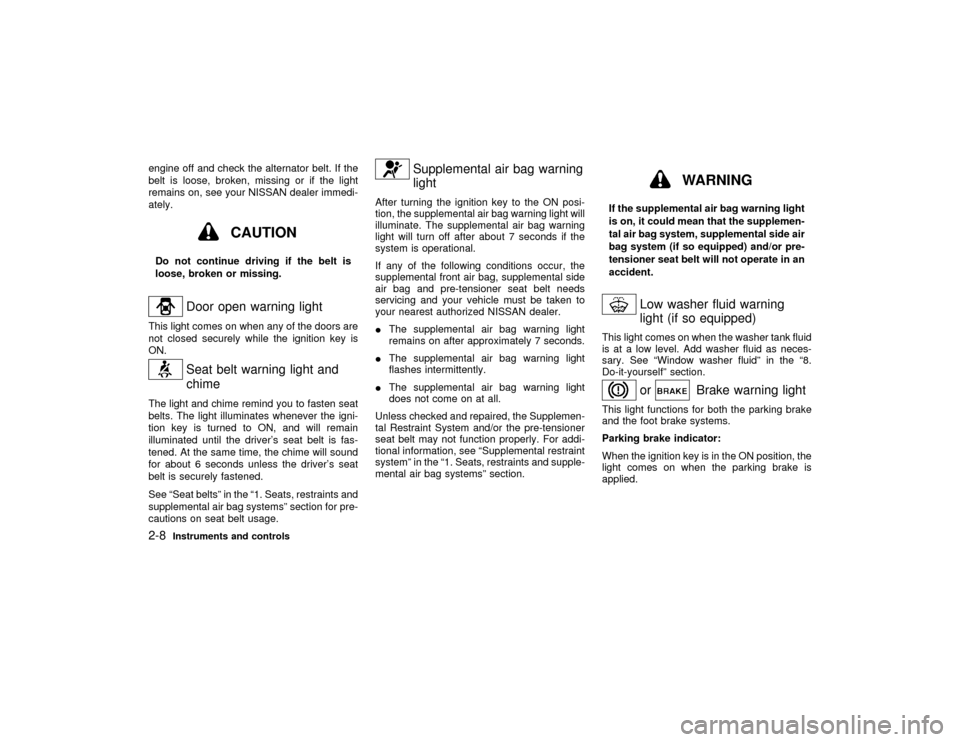
engine off and check the alternator belt. If the
belt is loose, broken, missing or if the light
remains on, see your NISSAN dealer immedi-
ately.
CAUTION
Do not continue driving if the belt is
loose, broken or missing.
Door open warning light
This light comes on when any of the doors are
not closed securely while the ignition key is
ON.
Seat belt warning light and
chime
The light and chime remind you to fasten seat
belts. The light illuminates whenever the igni-
tion key is turned to ON, and will remain
illuminated until the driver's seat belt is fas-
tened. At the same time, the chime will sound
for about 6 seconds unless the driver's seat
belt is securely fastened.
See ªSeat beltsº in the ª1. Seats, restraints and
supplemental air bag systemsº section for pre-
cautions on seat belt usage.
Supplemental air bag warning
light
After turning the ignition key to the ON posi-
tion, the supplemental air bag warning light will
illuminate. The supplemental air bag warning
light will turn off after about 7 seconds if the
system is operational.
If any of the following conditions occur, the
supplemental front air bag, supplemental side
air bag and pre-tensioner seat belt needs
servicing and your vehicle must be taken to
your nearest authorized NISSAN dealer.
IThe supplemental air bag warning light
remains on after approximately 7 seconds.
IThe supplemental air bag warning light
flashes intermittently.
IThe supplemental air bag warning light
does not come on at all.
Unless checked and repaired, the Supplemen-
tal Restraint System and/or the pre-tensioner
seat belt may not function properly. For addi-
tional information, see ªSupplemental restraint
systemº in the ª1. Seats, restraints and supple-
mental air bag systemsº section.
WARNING
If the supplemental air bag warning light
is on, it could mean that the supplemen-
tal air bag system, supplemental side air
bag system (if so equipped) and/or pre-
tensioner seat belt will not operate in an
accident.
Low washer fluid warning
light (if so equipped)
This light comes on when the washer tank fluid
is at a low level. Add washer fluid as neces-
sary. See ªWindow washer fluidº in the ª8.
Do-it-yourselfº section.
or
Brake warning light
This light functions for both the parking brake
and the foot brake systems.
Parking brake indicator:
When the ignition key is in the ON position, the
light comes on when the parking brake is
applied.
2-8
Instruments and controls
Z
00.1.17/A33-D/V5.0
X
Page 56 of 239
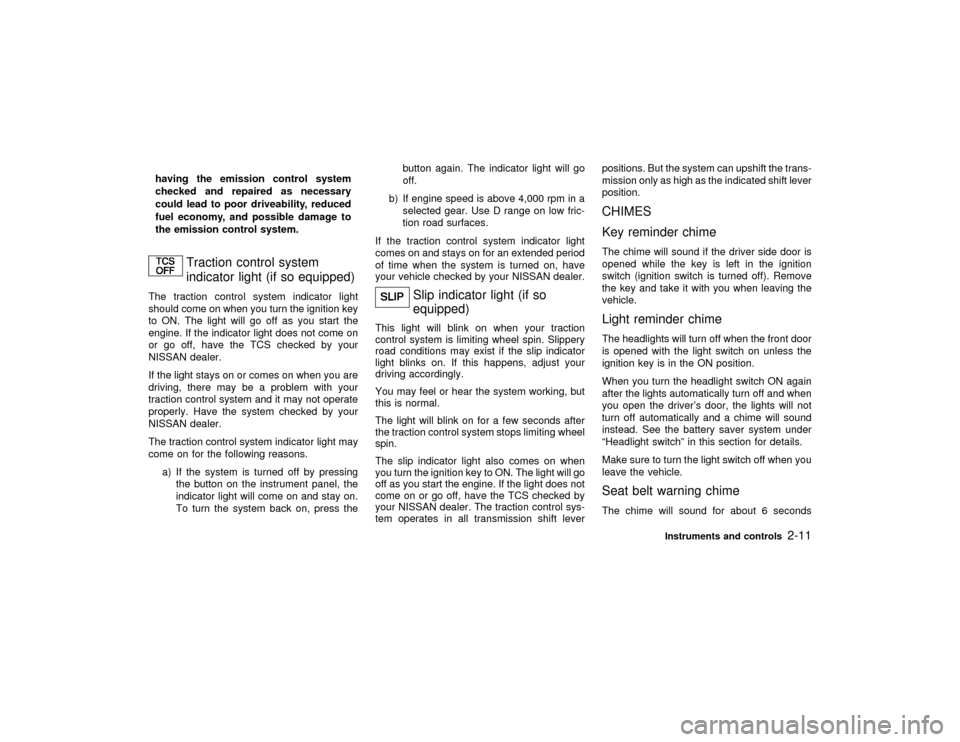
having the emission control system
checked and repaired as necessary
could lead to poor driveability, reduced
fuel economy, and possible damage to
the emission control system.
Traction control system
indicator light (if so equipped)
The traction control system indicator light
should come on when you turn the ignition key
to ON. The light will go off as you start the
engine. If the indicator light does not come on
or go off, have the TCS checked by your
NISSAN dealer.
If the light stays on or comes on when you are
driving, there may be a problem with your
traction control system and it may not operate
properly. Have the system checked by your
NISSAN dealer.
The traction control system indicator light may
come on for the following reasons.
a) If the system is turned off by pressing
the button on the instrument panel, the
indicator light will come on and stay on.
To turn the system back on, press thebutton again. The indicator light will go
off.
b) If engine speed is above 4,000 rpm in a
selected gear. Use D range on low fric-
tion road surfaces.
If the traction control system indicator light
comes on and stays on for an extended period
of time when the system is turned on, have
your vehicle checked by your NISSAN dealer.
Slip indicator light (if so
equipped)
This light will blink on when your traction
control system is limiting wheel spin. Slippery
road conditions may exist if the slip indicator
light blinks on. If this happens, adjust your
driving accordingly.
You may feel or hear the system working, but
this is normal.
The light will blink on for a few seconds after
the traction control system stops limiting wheel
spin.
The slip indicator light also comes on when
you turn the ignition key to ON. The light will go
off as you start the engine. If the light does not
come on or go off, have the TCS checked by
your NISSAN dealer. The traction control sys-
tem operates in all transmission shift leverpositions. But the system can upshift the trans-
mission only as high as the indicated shift lever
position.
CHIMES
Key reminder chimeThe chime will sound if the driver side door is
opened while the key is left in the ignition
switch (ignition switch is turned off). Remove
the key and take it with you when leaving the
vehicle.Light reminder chimeThe headlights will turn off when the front door
is opened with the light switch on unless the
ignition key is in the ON position.
When you turn the headlight switch ON again
after the lights automatically turn off and when
you open the driver's door, the lights will not
turn off automatically and a chime will sound
instead. See the battery saver system under
ªHeadlight switchº in this section for details.
Make sure to turn the light switch off when you
leave the vehicle.Seat belt warning chimeThe chime will sound for about 6 seconds
Instruments and controls
2-11
Z
00.1.17/A33-D/V5.0
X
Page 67 of 239
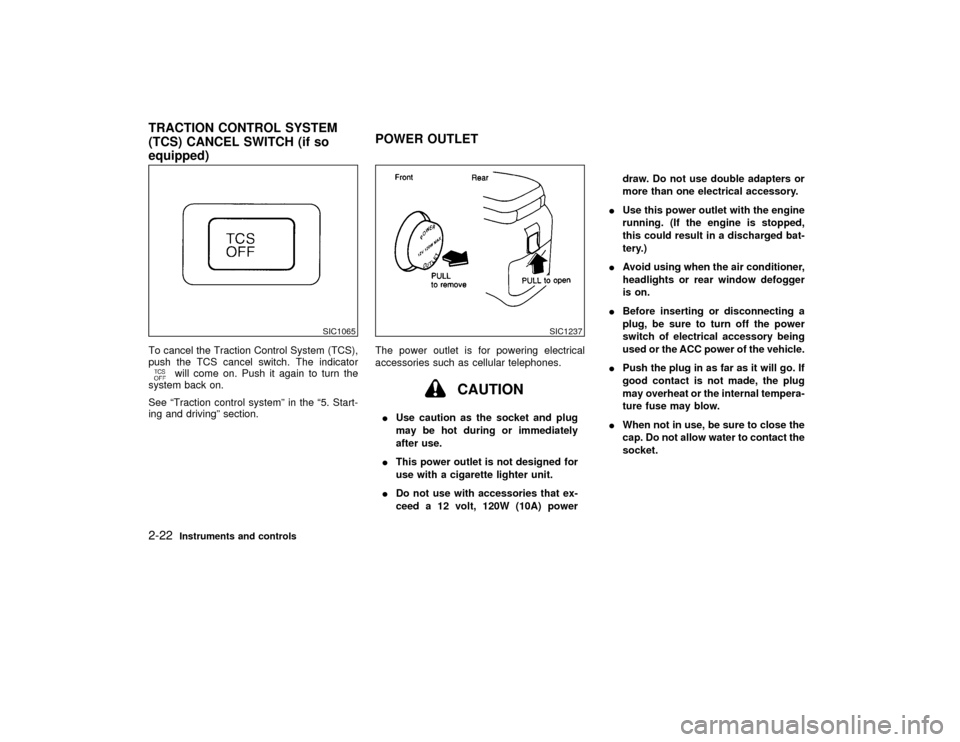
To cancel the Traction Control System (TCS),
push the TCS cancel switch. The indicator
will come on. Push it again to turn the
system back on.
See ªTraction control systemº in the ª5. Start-
ing and drivingº section.The power outlet is for powering electrical
accessories such as cellular telephones.
CAUTION
IUse caution as the socket and plug
may be hot during or immediately
after use.
IThis power outlet is not designed for
use with a cigarette lighter unit.
IDo not use with accessories that ex-
ceed a 12 volt, 120W (10A) powerdraw. Do not use double adapters or
more than one electrical accessory.
IUse this power outlet with the engine
running. (If the engine is stopped,
this could result in a discharged bat-
tery.)
IAvoid using when the air conditioner,
headlights or rear window defogger
is on.
IBefore inserting or disconnecting a
plug, be sure to turn off the power
switch of electrical accessory being
used or the ACC power of the vehicle.
IPush the plug in as far as it will go. If
good contact is not made, the plug
may overheat or the internal tempera-
ture fuse may blow.
IWhen not in use, be sure to close the
cap. Do not allow water to contact the
socket.
SIC1065
SIC1237
TRACTION CONTROL SYSTEM
(TCS) CANCEL SWITCH (if so
equipped)POWER OUTLET2-22
Instruments and controls
Z
00.1.17/A33-D/V5.0
X